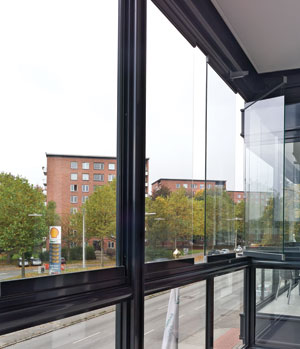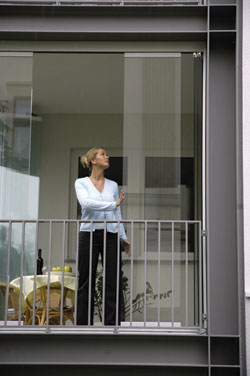Nature and Nurture: The Sustainable Benefits of All-Glass Operable Double-Wall Systems
Energy Savings and Carbon Reduction
The Nijverdal project is being closely monitored to assess the success of all of these integrated design strategies. These measures include the:
- energy consumption of the mechanical systems
- system temperatures required for heating or cooling
- temperature of the gas boiler
- pump run time and power requirements for the geo-thermal wells
- internal air temperature and CO2 content of the office space
- external weather data
- total power requirements
 |
The inside view from the balcony enclosed with an all-glass operable wall system Photo courtesy of NanaWall Systems Inc. |
By monitoring performance adjustments can be made to the heat pump run times and air quality. To date, studies show that the amount of primary energy used is very low and users report high satisfaction with their ability to change their environment. Engineering data shows that this building is being heated and cooled by approximately 2.5 KW per hour or the amount of energy that is used to power a hair dryer.
The EPA portfolio manager is an online tool that categorizes average building consumption data as a means to benchmark the consumption of energy and as well as greenhouse gas emissions.5 A typical office building in the US with a climate similar to that of Nijverdal emits approximately 20 lbs. of CO2/sq. ft. total annual energy consumption based on the Administration's "2003 Commercial Building Energy Consumption Survey (CBECS)" and the updated EPA portfolio manager. The office building at Nijverdal was designed to target zero CO2 emissions and as such would be eligible to meet the 2030 challenge for the reduction of carbon emissions in the 21st century. According to the U.S. Energy Information Administration, liquid fossil fuels supply 38.5 percent of total U.S. energy consumption, natural gas 24.3 percent, and coal 21.2 percent. Fossil fuels supply 76 percent of the total building sector energy consumption. Fossil fuel energy consumption is expected to grow by 12 percent between 2010 and 2030 with 55 percent of this growth due to the building sector.
Carbon ReducingBalcony Retrofits
 |
All-glass walls can make the transitions between inside and outside almost seamless. Photo courtesy of NanaWall Systems Inc. |
According to the Property Assessed Clean Energy initiative sponsored by the National Association of Counties, the market potential for the renovation of commercial building retrofits to meet new energy codes is estimated to be $18 billion dollars annually over the next 10 years.6 Renovations that can provide energy saving as well as modernize the design aesthetics of a building are a good return on investments. From public housing to deluxe multi-storied ocean front condominiums, enclosing existing balconies with operable glass walls provide many design advantages including:
- adding more year round living space
- energy savings
- serving as a barrier to wind and rain
- creating cross ventilation and increasing fresh air intake
- draft and noise reduction
- protecting furniture from sun damage
- protecting degradation of the exterior balcony and interior window system.
- enhancing the architectural image
Rather than tear down the Stawog public housing in Bremerhaven, Germany, architects chose to renovate the plain three story buildings as a demonstration of sustainable design principles. The mandated goal was to reduce the building's CO2 emissions by 70 percent. The architects and engineers used three main strategies in this upgrade. They installed new heating systems with central controls, added photovoltaic panels and they upgraded the thermal performance of the building envelope by adding new insulation, better windows and enclosing the balconies with all-glass operable wall systems. The balcony glazing was installed behind the safety rail and on top of the rail and brought both thermal benefits as well as added more year round usable space for the residents.
Engineers calculate that this renovation reduced CO2 emissions by 80 percent. The renovations exceeded government mandates by 10 percent. Studies show that the balcony glazing alone contributes up to 20 percent towards the reduction of CO2 emissions.7 This project continues to be monitored for performance and occupant comfort by university researchers and public housing authorities.









